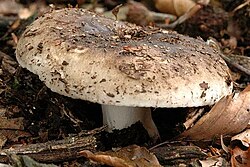| Russula adusta | |
|---|---|
 | |
| Scientific classification | |
| Kingdom: | Fungi |
| Division: | Basidiomycota |
| Class: | Agaricomycetes |
| Order: | Russulales |
| Family: | Russulaceae |
| Genus: | Russula |
| Species: | R. adusta |
| Binomial name | |
| Russula adusta | |
| Synonyms | |
List
| |
| Russula adusta | |
|---|---|
| Gills on hymenium | |
| Cap is convex or depressed | |
| Hymenium is adnate | |
| Stipe is bare | |
| Spore print is white | |
| Edibility is poisonous | |
Russula adusta, commonly known as the blackening brittlegill or blackening russula, is a species of gilled mushroom. It is a member of the Russula subgenus Compactae. [1] The cap is brown to gray and somewhat shiny, with a mild taste and, reportedly, an odor of empty wine barrels. [1] It has a propensity to turn black from cutting or bruising and has white spores. [1] Similar species include Russula albonigra and R. densifolia . [1]
Contents
Russula adusta is found in woodlands of Europe and North America, growing under conifers.